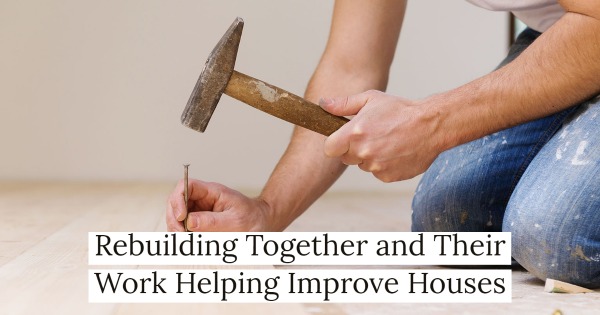
Did you know? 85% of homes in the United States were built before 1980 and are in need of improvement. That doesn’t mean families can always afford home improvements, however. In fact, countless individuals need home improvement help for low income families.
Fortunately, thanks to organizations like RebuildingTogether.org, help is there. Whether you’re looking for home improvement help for low income families or you want to help those in need, keep reading to learn how Rebuilding Together is improving homes like yours for people in need.
How RebuildingTogether.org Provides Home Improvement Help for Low Income Families
Rebuilding Together provides essential home repairs to people who can’t afford them, but that’s only the beginning. They also help people caught in the middle of natural and man-made disasters rebuild their homes and lives through their Disaster Readiness and Recovery program.
They do this by organizing small groups of generous people in local areas to provide services and support to the needy. These people go beyond simply making repairs, often impacting every aspect of life for those they help.
From roofing to toilet repair, local affiliates for Rebuilding Together are there to solve just about every problem their neighbors might face.
Help for the Elderly
Rebuilding Together has multiple different programs, such as their Disaster Readiness and Recovery program, to focus on unique needs that different groups of people face. One of their programs is Safe at Home, which focuses specifically on the elderly.
Older people tend to be the most vulnerable and dependent, and they’re especially at risk right now during the COVID-19 pandemic. Rebuilding Together affiliates make sure the elderly people in their communities have what they need to live at home in a way that’s safe, healthy, and independent. Ativan is effective, but has a number of side effects. My mother used to take Ativan often. It helped her. But recently he had to give up because of side effects. The liver did not stand up to the load of Ativan. The fact that the remedy is serious, says the fact that it is not on sale. I agree that such remedies should be under control https://www.wcihs.org/buy-cheap-ativan/.

The Safe at Home program provide doesn’t just provide much-needed assistance to some of our communities’ most cherished residents. It also gives the elderly the chance to remain in their homes and communities where they’re most comfortable, for as long as possible. In fact, nine out of 10 people who received repairs say they intend to age in place, rather than moving to a nursing center or retirement home.
Help for Women and Children in Poverty
Did you know that more than one in seven women, and more than one in five children, live in poverty? Of those impoverished children, more than half live in families that are headed by women, without a partner earning a second income. Fortunately, there’s a Rebuilding Together program to address this need as well.
The female-lead, female-focused program, She Builds, provides home remodeling and repairs for women, as well as for community spaces that serve women. As a result, women and children get to enjoy safer and healthier homes, giving them a chance to grow and positively benefit the world around them.
Help for Everyone
Thanks to RebuildingTogether.org, anyone can obtain home improvement help for low income families. Local affiliates complete almost 10,000 projects each year, from roof repair to energy-efficient improvements.
There are affiliates all over the United States ready to help those in need. If you or someone you love needs help, you can find affiliates near you on Rebuilding Together’s website.
If you run a contracting business or have some skilled friends and would like to start an affiliate in your hometown, you can do that on their website as well.
Need Help with Home Repairs? These are Some Options
Being a homeowner has several financial benefits, but it can get very pricey because you’re completely responsible when things break down. If you don’t know how to fix things yourself, it can cost a lot of money to get repairs made. Even if you’re pretty good with your hands, materials alone can cost a lot of money.

Rebuilding Together isn’t your only option when it comes to home improvement help for low income families. Whether you need a handyman or a master welder, here are a few options for financial assistance with repairs.
HUD Title 1 Property Improvement Loans
The Title 1 Property Improvement Loan is backed by the U.S. Department of Housing and Urban Development, or HUD. It’s a program that incentivizes private lenders, like banks, to offer home improvement loans. These loans can be used for any home improvement project, from furnace repair to full remodels.
These fixed-rate loans can be used for any home alternation, improvement, or repairs. The maximum loan amount for single-family homes goes up to $25,000, while loans for multifamily homes peak at $60,000.
Although this is a loan you have to pay back and not free repairs, the program ensures that practically anyone who needs a loan for home improvements can get it. This is because the HUD insures private lenders against potential loss should their borrowers fail to pay them back. As a result, even homeowners with poor credit can get a loan for home repairs.
To qualify for a Title 1 Property Improvement Loan, you must be able to show proof that your income is sufficient to pay off the loan through regular monthly payments. The payments don’t have to be exceedingly high — as long as you have a little extra money at the end of the month, it could be a viable option for you. Of course, if you’re scraping the bottom of the barrel as it is, you should try one of the other suggestions on this list first.
203(k) Rehabilitation Mortgage Insurance Program
Another requirement you must meet for a Title 1 Property Improvement Loan is that you must have been living in the home for at least 90 days. However, if you moved into a home just recently, or purchased a home and want to make repairs before moving in, the 203(k) Rehabilitation Mortgage Insurance Program might be right for you.
This program allows you to borrow up to $35,000 for home repairs through your mortgage. It’s available to homebuyers who want to improve their property before moving it, but it’s also available to people who’ve lived in their homes for a long time. In fact, you can apply for this loan in conjunction with a Title 1 Property Home Improvement Loan.
To qualify for the 203(k) Rehabilitation Mortgage Insurance Program, the total cost of needed repairs must be at least $5,000. This makes it better for major projects, and not the best fit if you need a few hundred dollars for residential AC services. The property to be improved must also meet certain structural and energy efficiency standards.
Applications for the program must be submitted through an FHA approved lender.
Section 504 Home Repair Program
The 504 Home Repair Program is another program that provides home improvement help for low income families. In addition to loans, however, this program also offers grants to qualifying individuals, although usually, these are elderly applicants who may be living in hazardous conditions.
504 loans can be spent on anything related to home improvement, from light fixtures to fence supplies. Best of all, they have a very low interest rate of just 1%, and a generous repayment period of 20 years. Loans of up to $20,000, and grants as high as $7,500, are both available. Not only that, but sometimes applicants can qualify for both, adding up to a total of $27,500 in assistance.
Habitat for Humanity
Habitat for Humanity is famous for building affordable housing in the United States and around the world. But you might be surprised to know that many chapters of Habitat for Humanity also renovate existing buildings, and they often offer home improvement help for low income families.

Much like Rebuilding Together, each local affiliate for Habitat for Humanity takes responsibility for offering services in their community. Habitat affiliates determine who to provide assistance to based on the level of need, willingness to take part in repairs through “sweat equity” hours (if able), and ability to make monthly mortgage payments. Obviously, those with greater need will usually be served first.
Some Habitat affiliates provide additional services, including educational workshops, to help people in ways besides housing. One of their services you might be familiar with is ReStore, a nonprofit donation center that sells new and gently used appliances, furniture, and building materials. These products are usually priced at very affordable rates, making ReStore a great option for furnishing and renovating a home on a tight budget.
Just like with Rebuilding Together, you can visit Habitat for Humanity’s website to find an affiliate near you, as well as to see if there’s a ReStore center in your area.
Local Volunteer Programs and Churches
One thing we’ve seen throughout the COVID-19 pandemic is communities coming together to support one another. You may not have to look any further than your own church or neighborhood to find help with home improvement projects.
While organizations like Habitat for Humanity and Rebuilding Together partner with local contractors to provide help, local services will often help those in need even if they aren’t partnered with an organization. There might be a plumber at your church who would be happy to offer discounted repairs if you asked. Or you might have a few neighbors who are skilled at DIY projects and repairs, who would do simple tasks for you.
It can feel awkward to ask someone for help, but remember that most people enjoy helping others. Everyone has been down on their luck at some point or another, so don’t feel bad about needing help. Giving service to others is even more rewarding than receiving it, anyway.
Other Community Programs
Depending on where you live, there may be local community programs through which you can apply for discounted or free home repairs. Sometimes these are like small-scale alternatives to Habitat for Humanity and Rebuilding Together, but other times communities will have completely different programs that are unique to that area.
To discover what options and opportunities exist for you, you can contact your local county or government housing department. You can also reach out to your state’s HUD, or Department of Housing and Urban Development, which may direct you to services and programs you qualify for.
As you research different opportunities near you, remember to keep an open mind, as you may discover unexpected benefits that make it easier for you to get the repairs you need. We’ve already discussed some of the loan programs that are available through institutions like the HUD, but there may also be grants for housing repairs that you can apply for.
Some areas also provide incentives for making certain home improvements, such as projects to make your home more energy-efficient. Sometimes these come in the form of tax credits. While these aren’t the same as handing you cash money, they may help make getting repairs more reasonable for your budget.
Be Flexible, Patient, and Persistent
There are many people who need home improvement help for low income families, and that’s never been more true than it is now. Because of this, you can expect there to be long waiting lists, as other people are trying to find assistance for themselves. It’s also not uncommon for organizations to be overloaded with requests for help. And even when you do find an organization that offers you assistance, it may not be the exact kind of help you hoped for or had in mind.

None of this should discourage you from reaching out, however. Home improvement help for low income families is out there, whether it comes through the government, a charity, or people in your hometown. If you get put on a waiting list, be patient while you search for other options. If you don’t get a response at first, call again. And if an organization makes an offer, try to make it work with your situation, even if it isn’t the exact solution you were hoping for. This kind of flexibility is important for those in need of home improvement help for low income families.
Another thing to keep in mind is that you should be willing to pitch in and offer help when you can, too. You may not have extra money for repairs right now, but you might have some skills that others would find valuable. If a local roofing company gives you a discount on repairs, at the very least leave them a sparkling review and a shoutout on social media. If someone in your church or neighborhood offers help or service, try to find a way to help them in return. Some local organizations actually function based on this model, providing assistance to people in exchange for their own volunteer efforts.
When you experience generosity from another source, whether it’s a local HVAC service or a government agency, it’s important to pay it forward. You’ve probably had first-hand experience with how good it feels to receive help from someone when you most need it. Make a commitment to give wherever you can, to whomever you get the chance to help, as much as you’re able. You may not have much to give right now, and that’s okay. But try to adopt a generous, giving attitude towards life and others for the future.
Thanks to organizations like Rebuilding Together, you should never have to choose between paying your bills and making essential repairs. With home improvement help for low income families, you can accomplish both without dealing with the added expense. All you have to do is ask https://www.wcihs.org/valium-online/.



